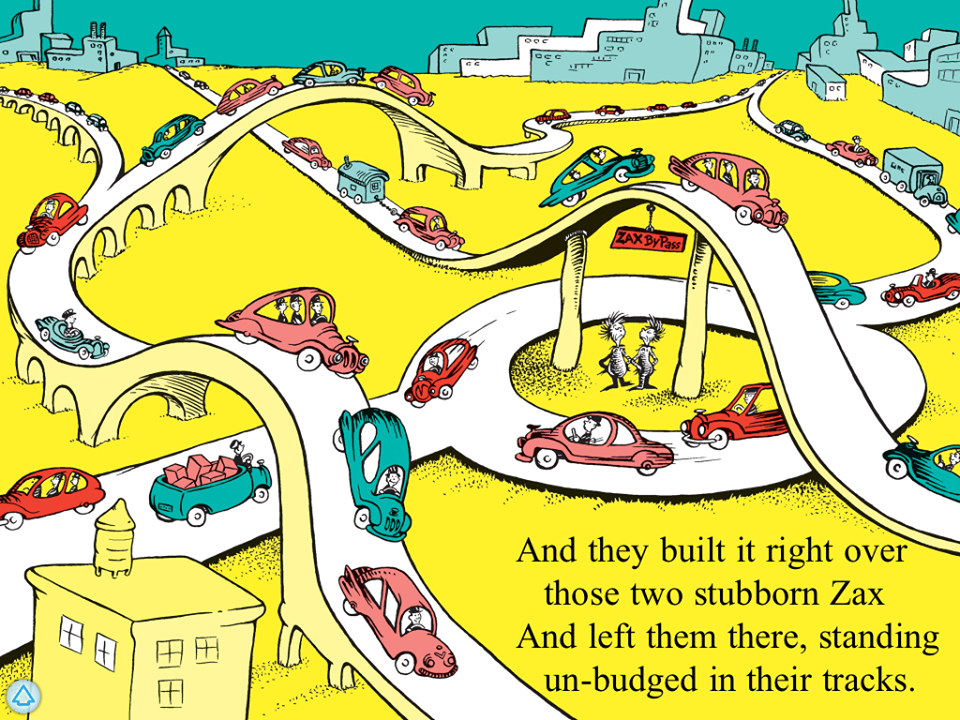The Zax (Change and Innovation)
I recently read The Zax by Dr. Seuss with my 5-year old daughter. I’ve probably read this story, as well as many other Seuss classics, dozens of times with my older boys. For some reason, when revisited The Zax, I was struck by the metaphor for change and innovation. If you are not familiar with this story, read it now before continuing on. Don’t have a handy copy? No worries! You can watch the video below. Don’t worry, I’ll wait.
So, here are two Zaxes: a North-Going Zax and a South-Going Zax. It is here, standing foot to foot and face to face where our metaphor begins. The obvious place to start is to use this story to teach concepts of conflict resolution or pride or compromise. However, if you dig just a bit deeper, I feel like a different metaphor appears.
“Look here, now!” the North-Going Zax said, “I say!
You are blocking my path. You are right in my way.
I’m a North-Going Zax and I always go north.
Get out of my way, now, and let me go forth!”
“Who’s in whose way?” snapped the South-Going Zax.
“I always go south, making south-going tracks.
So you’re in MY way! And I ask you to move
And let me go south in my south-going groove.”
Each Zax is confident in where they are going, and how they are getting there. Both have been traveling in these well-worn paths for, presumably, many years and don’t see any reason to change. Complacency is easy to achieve. Adam Grant, author of Originals: How Non-Conformists Move the World, describes this phenomenon when discussing the Internet browser preferences of customer service employees. Michael Houseman was examining why certain customer service employees either stayed or left their current jobs if unhappy. He noticed a strange connection between those who stayed and the Internet browser they used. For example, Internet Explorer and Safari come standard on either new PC’s or Macs. These are the default browser. Employees who used these browsers are the same ones who let complacency rule their jobs. They saw their jobs as fixed and unchanging, despite being unhappy. Employees who use Firefox or Chrome, sought out something different because they wanted a different Internet experience. They took initiative to change their browser. These are the same employees who not only stayed in their jobs, but looked for ways to innovate or do something different within customer service, thereby having better ratings by customers.
This is known as system justification. Political psychologist John Jost studied how people responded to undesirable default conditions. His theory is that people will justify or rationalize the status quo as legitimate, even if they are unhappy with their condition. They take what is given and do not strive to make any sort of changes; exactly as our North and South-going Zaxes are doing.
Then the North-Going Zax puffed his chest up with pride.
“I never,” he said, “take a step to one side.
And I’ll prove to you that I won’t change my ways
If I have to keep standing here fifty-nine days!”
Now, it could be argued that they are both just full of pride (especially since that is the adjective Seuss uses), but I see something different. Both are complacent with their current state. They have been doing things, traveling in their paths and grooves, for a number of years. Why fix something when it is not broken? Why do something different? Unfortunately, both Zaxes are extrememly stubborn and will not step to one side. Adam Grant goes on to discuss how we live in a world of defaults, and that we are socialized to accept these defaults as the status quo. He writes, “Rules and systems are created by people” (Grant, 2016, p. 8). That is even true here in the Prairie of Prax:
“And I’ll prove to YOU,” yelled the South-Going Zax,
“That I can stand here in the prairie of Prax
For fifty-nine years! For I live by a rule
That I learned as a boy back in South-Going School.
Never budge! That’s my rule. Never budge in the least!
Not an inch to the west! Not an inch to the east!
I’ll stay here, not budging! I can and I will
If it makes you and me and the whole world stand still!”

The South-going Zax states outright that he learned in school to “never budge.” He will continue to stand there for 59 years because of how he was socialized. Unfortunately, in this story, Dr. Seuss doesn’t give us an example of the other type of person: one who when confronted with a dissatisfying status quo, seeks to change it. “When we become curious about the dissatisfying defaults in our world, we begin to recognize that most of them have social origins…and that awareness gives us the courage to to contemplate how we can change them” (Grant, 2016, p. 8). Neither Zax has been socialized to question their realities. They just continue to move through life in the same path they always have walked. They never question the rules that they learned in school. What happens?
Well…
Of course the world didn’t stand still. The world grew.
In a couple of years, the new highway came through
And they built it right over those two stubborn Zax
And left them there, standing un-budged in their tracks.
Nothing happens. No innovation. No creativity. They literally stand in place as the entire world develops around them! Innovation takes curiosity, but you won’t be curious if you are taught never to question things. Kids are naturally curious. Tony Wagner (2012) studies innovation; where it comes from, how it develops, and how to nurture it. In writing Creating Innovators: The Making of Young People Who Will Change the World, he interviewed thousands of creative innovators, their parents, and mentors. The commonality he saw in the lives of children who grew up to be creative and an innovator: a balanced “respect for authority with constructive engagement and constructive rebellion–teaching kids to be strong, but give them the walls to push against” (Wagner, 2012, p. 205). My guess is that the parents of each Zax taught their children to never question authority; in fact never rebel against anything different from what they were taught. In other words, blind obedience.
As I read this story to my daughter who is passionate, sometimes willful, and extremely stubborn, I thought about how I am teaching her to be creative and innovative. Certainly, I want her to grow up to change the world. I want her to see areas for improvement. I want her to stand firmly in a belief, but also be flexible to maneuver and compromise in order to affect change. This is the same lesson I taught my 5th graders for years: question me as a teacher, but do so in a respectful manner. Don’t like how I am teaching Math, tell me and then work with me to improve it. If you are unhappy with the system, then let’s change it together. Otherwise, we will be stuck standing underneath the Zax Bypass and innovation drives right past us.


 Previous Post
Previous Post Next Post
Next Post